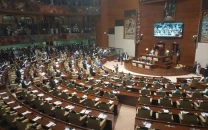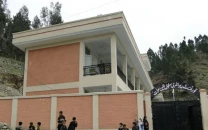The NRO revisited

The NRO revisited
Institutional encroachment has emerged as a major issue. Who is encroaching on whose territory? The Supreme Court maintained that the executive encroached on what was the judiciary's turf by withdrawing cases without the permission of courts. Critics of the judgment argued that the judiciary encroached upon the executive's space by establishing monitoring cells to oversee the implementation of the court’s orders.
Still, others complain that the judiciary is seeking to supersede the legislature by giving constitution-making judgments. Analysts generally believe that courts make uncertain constitutionalism in Pakistan even more uncertain by reinterpreting legal provisions, often in supersession of their previous judgments.
This entails the selective use of constitutional articles that contradict certain others, which would probably be picked up by a different bench at a future date.Articles 62 and 63 contain Islamic provisions relating to individual piety as initiated by a military dictator, subsequently passed as the eighth amendment. The obvious purpose was to disqualify political opponents from aspiring and contesting for public office.
The apex court’s use of these articles and also Article 227 – the repugnancy clause – raises a new question. Should parliament delete all amendments in the constitution carried out by military rulers? After all, constitutional amendment no less than constitution making is the prerogative of the public representatives not military adventurers.
Is this the time for parliamentarians to address the issue of restoring the pre-eighth amendment Constitution? Second, there are the two gruesome instances of the Supreme Court rendering the power of amending the Constitution to the coup-maker: to Gen. Zia by Justice Anwarul Haq among others and to Pervez Musharraf by Justice Irshad among others, including Justice Iftikhar Chaudhry.
Under Musharraf, judges were twice subjected to the ignominious act of taking a new oath. Both PCO-I (2000) and PCO-II (2007) judges were thus beholden to the army. The lawyers’ movement protested against both the arbitrary suspension of Chief Justice Iftikhar Chaudhry in March 2007 and the unlawful dismissal of scores of judges in November 2007. After his restoration, the PCO-I Judges pushed the PCO-II judges out of the bench.
The PCO-I judges had validated Musharraf’s coup that was in violation of the Constitution. The PCO-II judges upheld his presidential candidature. The former now enjoy political legitimacy and public acceptance. The latter are denied both. Is it a case of discrimination against the PCO-II judges? Meanwhile, a third group of judges, restored piecemeal in 2008, enjoys office untainted by controversy.
The judgment and the post-judgment remarks of the honourable judges have stressed the need for the pursuit of cases of corruption against the accused, including the Swiss cases against President Zardari. People fear, and hope, that the noble pursuit of accountability for corruption would actually destabilize the system. Is it going to be the way the old adage goes: the way to hell is paved with good intentions?
The independence of the judiciary is rooted in the non-controversial character of courts, inasmuch as the making and breaking of governments does not depend on the rulings of courts. Why does the accountability process often boil down to ‘going after the big fish’? The answer lies in the agenda of discrediting the potential or actual wielders and contenders of power and not elimination of corruption per se.
The issue of discrimination against the public as per Article 25 used in the NRO judgment puts the old arguments on their heads, especially as the ‘stigma’ of corruption gains a new legitimacy.
The writer is a professor of economics at LUMS
(mohammed.waseem@tribune.com.pk)



















COMMENTS
Comments are moderated and generally will be posted if they are on-topic and not abusive.
For more information, please see our Comments FAQ